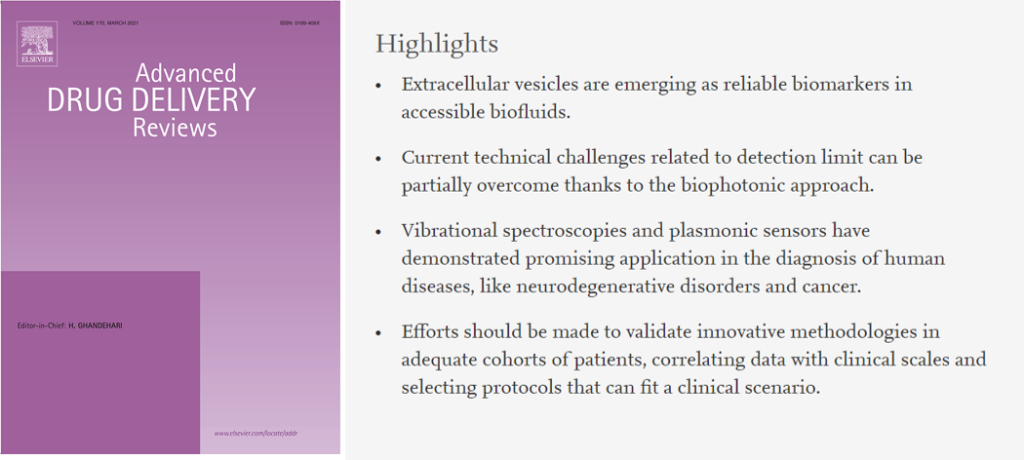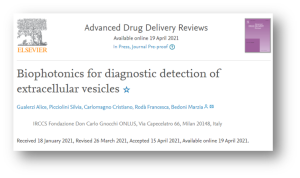The Laboratory of Nanomedicine and Clinical Biophotonics has recently published in the international and prestigoius journal Advanced Drug Delivery Reviews a review paper on the use of biophotonics and nanotechnologies in diagnostics.
What is biophotonics and why is it useful for future application in diagnostics?
Biophotonics includes multiple light-based methods that have already demonstrated promising application in the diagnosis of human diseases. Examples are Raman spectroscopy, surface plasmon resonance and flowcytometry.
(…) Optical methods have the potential to accurately obtain clinically relevant properties of particles, they include a wide range of techniques that rely on the interaction of a laser light with the biological sample and detect the scattering of photons or the fluorescence effect, with emerging application in the EV field
Currently, an emerging field of research is the one of EXTRACELLULAR VESICLES, i.e. nanosized particles released by all body cells that transport proteins, lipids, and nucleic acids from one tissue to another taking advantage also of the blood stream to reach distant organs.
Extracellular vesicles have been studied as vehicles of biomarkers for several pathologies, spanning from Alzheimer’s disease to cancer, to inflammatory and chronic disorders. Unfortunately, extracellular vesicles can be as small as 50 nanometers, thus conventional “cell-calibrated” methods might show inadequate resolution limits for vesicle detection with significant interference of contaminants during the analysis.
Spectroscopic and, more in general, biophotonic methods can help researchers in developing new procedures to detect early biomarkers for complex neurological and degenerative diseases, providing clinicians with powerful instruments for the fast and objective diagnosis and, potentially, in finding new targets for effective therapies.
(…) The biophotonic-based approaches described in the present review have in most cases managed to ameliorate the discrimination between nanovesicles and contaminants in the clinical sample by the enrichment of specific EV population or by increasing the performances of the proposed methodologies, in terms of higher resolution compared to traditional procedures or both, leading to moderate ore even excellent diagnostic accuracy.
Up to now, most of the proposed techniques for the detection of extracellular vesicles for diagnostic purposes, are still at the proof-of-concept level. Nonetheless the recent technological advancements suggest the possiblity to accelerate the translation of research to the clinical setting thanks to the remarkable performances obtained with human clinical samples.
To make a step forward in the diagnostic application of biophotonic platforms, we underline the need for i) proper selection of specimens; ii) adequate selection of patients’ cohort and correlation with current clinical scales; iii) easy and automatable EV isolation protocol that can fit the routine of a diagnostic laboratory; iv) reduced time of the analysis.
Reference to the published article: Gualerzi A, Picciolini S, Carlomagno C, Rodà F, Bedoni M. Biophotonics for diagnosticdetection of extracellular vesicles, Advanced Drug Delivery Reviews, 2021. doi: 10.1016/j.addr.2021.04.01






